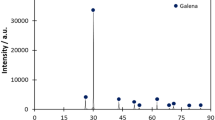Abstract
The electrochemical oxidation of galena in collectorless and collector flotation systems, particularly in strong alkaline media, was studied. The results show that, with pH value higher than 12.5 and potentials below 0.17 V, the oxidation products of galena are elemental sulfur and HPbO −2 . Elemental sulfur was present on the mineral surface in excess of oxidized lead species due to dissolution of HPbO −2 , which is beneficial to the flotation of galena. Under the same conditions, sphalerite and pyrite were depressed as a result of significant surface oxidation. Diethyldithiocarbamate (DDTC) was found to be the most suitable collector for galena flotation in strongly alkaline media. The very potential produced hydrophobic PbD2—the surface reaction product of DDTC with galena, is 0 to 0.2 V. Meantime DDTC can depress the surface over-oxidation of galena. Investigations also indicate that, in the range of − 0.9 V to 0.6 V, hydrophobic PbD2 can be firmly adsorbed on galena.
Similar content being viewed by others
References
Salamy S G, Nixon J G. The application of electrochemical methods to flotation research[A]. In: Recent developments in mineral dressing. London: Institution of Mining and Metallurgy, 1953. 503.
Wang Dianzuo. Potential adjustment flotation of sulfide mineral and collectorless flotation. In: The new developments of flotation theory. Beijing: Science Press, 1992. 79.
Feng Qiming, Chen Jin. Electrochemistry of sulfide minerals flotation(in Chinese)[M]. Changsha: Central South University of Technology Press, 1992. 125.
Kelebek S, Smith G W. Collectorless flotation of galena and chalcopyrite: correlation between flotation rate and the amount of extracted sulfur[J]. Miner Metall Process, 1989, 6(3): 123–129.
Hu Qingchun, Wang Dianzuo, Li Baidan. An electrochemical investigation of the diethyldithiocarbamate-galena flotation system[J]. Int J Miner Process, 1992, 34: 289–305.
Guy P J, Trahar W J. The influence of grinding and flotation environments on the laboratory batch flotation of galena[J]. Int J Miner Process, 1984, 12: 15–38.
Buckley A N, Woods R. An X-ray photoelectron spectroscopic investigation of the surface oxidation of sulfide minerals [A]. In: Richardson P E ed. Proceedings International symposium on electrochemistry in Mineral and Metal Processing [C]. The Electrochemical Society, Inc, NJ, 1984. 286–302.
Wadsworth M E, Duby P. Advances in mineral processing [A]. In: Somasundaran P ed. Proceedings of a symposium honoring Abiter N on his 75 th birthday. New Orieans, 1986.
Gu Guohua, Hu Yuehua, Qiu Guanzhou, et al. Electrochemistry of sphalerite activated by Cu2+ ion[J]. Trans Non ferrous Met Soc China, 2000, 10(special issue): 64–67.
Author information
Authors and Affiliations
Additional information
Foundation item: The National Science Fund for Distinguished Young Scholars(No. 59925412);
Biography of the first author: GU Guohua, associate professor, doctor, majoring in the natural resources multipurpose use and electrochemical flotation.
Rights and permissions
About this article
Cite this article
Gu, Gh., Hu, Yh., Qiu, Gz. et al. Potential control flotation of galena in strong alkaline media. J Cent. South Univ. Technol. 9, 16–20 (2002). https://doi.org/10.1007/s11771-002-0004-4
Received:
Issue Date:
DOI: https://doi.org/10.1007/s11771-002-0004-4




